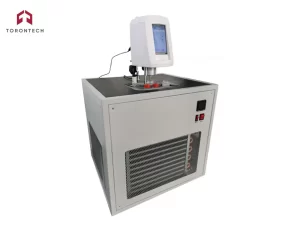Low Temperature Brookfield Viscometer
Low Temperature Brookfield Viscometer TT-2983
The TT-2983 Low Temperature Brookfield Viscometer complies with the ASTM D2983 Standard Test Method for Low-Temperature Viscosity of Automatic Transmission Fluids, Hydraulic Fluids, and Lubricants using a Rotational Viscometer.
Low Temperature Brookfield Viscometer TT-2983 utilizes Brookfield viscometers with appropriate torque to measure the low shear-rate viscosity of lubricants. The test is conducted across a viscosity range of 500 to 900,000 mPa·s within a low temperature range suitable for the viscometer head's capacity. Primarily utilized for testing liquid lubricants such as gear oils, torque and tractor fluids, as well as industrial and automotive hydraulic oils.
The low-temperature, low-shear-rate viscosity of automatic transmission fluids is crucial for the proper functioning of various mechanical devices. Assessing the viscometric properties of these oils and fluids at low temperatures is a common method to determine their suitability for use. This test method is widely used in various specifications.
1. Four precise spindles strictly adhere to the standard, ensuring excellent repeatability.
2. We utilize a semiconductor cooling bath with transparent observation. The inner LED light enhances convenience during operation.
3. Standard test tube stator with an inner diameter of 22~22.5mm and a length of 120mm.
4. Imported digital rotary viscometer equipped with seven gear spindle speeds.
5. Microcomputer temperature controller with PID control, featuring a PT100 temperature sensor for high precision.
6. Broad viscosity detection range: 1000~1000000 mPa.s.
1. Applicable standards: ASTM D2983
2. Refrigeration method: Semiconductor refrigeration
3. Temperature control method: Digital PID temperature controller
4. Temperature control range: Ambient temperature~-70±0.1℃
5. Required lowest test temperature: -40℃
6. Rotation speed: 0.5~60r/min
7. Power: 1200W
8. Rated voltage: AC220V 50HZ (110V also available)
Test summary
An oleaginous fluid sample undergoes a series of steps in preparation for viscosity analysis. Initially, it is preheated and left to stabilize at room temperature. Subsequently, the sample is poured into a glass cell to a specific depth, with an insulated or uninsulated spindle inserted through a specialized stopper and suspended by a clip. The contained sample is then cooled to a predetermined temperature over a span of 2 hours, with semiconductor refrigeration used as the cooling system. Following this cooling period, the sample is analyzed using a Brookfield viscometer. Depending on the model of the viscometer utilized, the viscosity of the test fluid is either directly read from the viscometer or calculated based on the resultant torque reading, relative to the chosen temperature.
Reagent
1.Petroleum ether:60~90℃,analytically pure
2.95%ethyl alcohol: analytically pure





